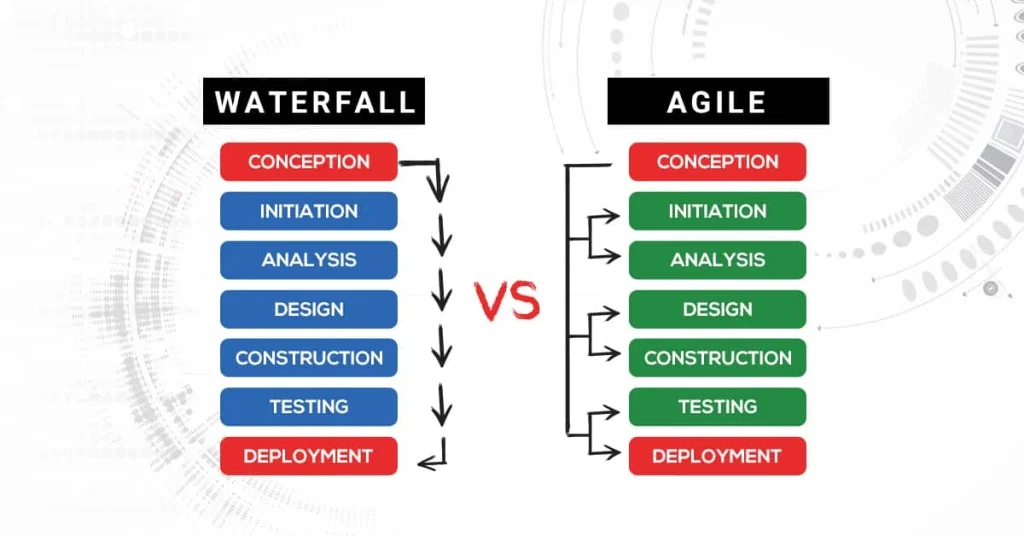How traditional development impedes agility
In today’s fast-paced business environment, agility is crucial to remain competitive. However, traditional development methods like the rigid waterfall approach often impede agility.
Critical issues with traditional development include:
Rising standards of excellence from consumers
Customers have growing expectations of companies and enterprises. The bar for has been raised as new technologies are adopted rapidly into the mainstream.
Shorter product life cycles are necessary because of the rising threat of more agile startups, innovative technologies, and novel business models. Months spent using conventional methods to hand-code an app raise the risk that the product will be outdated by the time it is released.
Business and it departments work in silos
In many organizations, business and IT departments operate independently of each other, often without any clear communication or collaboration between them. This can lead to silos where the company may have one agenda, and IT may have another. These silos often result in an “us vs them” mentality and can create roadblocks to progress, innovation, and agility.
Constraints on the flexibility of software design
Many IT departments still employ ‘waterfall’ application development, which necessitates guessing (at best) what users will need or want in the future. This leaves business users hoping that IT gets the big picture and can implement it.
IT also needs help to keep up with the business’s demands. They often live in a backlog, working on projects that take months or even years to complete. By the time they finish, the solution needs to be updated, and the business has moved on to something else.

Vendor lock-in
If your company decides to purchase rather than construct, it must be prepared for a long-term partnership with the seller. This begs the query; how resilient will your apps be to change in the future?
Costly commitment to maintaining existing hardware and software
Many companies still use old technologies that are difficult to maintain and upgrade. And even if they want to switch to a more modern approach, they may need more skills or resources to transition.
Key takeaway
Traditional development can lead to messy workflow and a huge IT backlog as the number of projects grows. This negatively impacts your team’s efficiency and digital transformation journey by reducing the agility and flexibility in development.
Agile methodology is nothing new. But it can always be the perfect solution on paper without a suitable supported tool. And the emerging low-code technology is said to transform Agile to be better and more usable with its ability.
What is low-code?
Low-code is an approach to software development that emphasizes visual modeling and automation to create applications quickly and efficiently. Using low-code platforms, developers can build applications by dragging and dropping pre-built components rather than hand-coding every element from scratch.
This approach reduces the manual coding and makes it possible for non-technical users to participate in the development process. Low-code also streamlines the process, allowing teams to work and iterate faster.
If you’re looking to grasp the subject more thoroughly, invest some time in reading this article, “Low-code Development: What It Is and Why It’s Important“
How can low-code boost agility?
Low-code platforms are well-suited to agile development methodologies, allowing organizations to quickly iterate on software solutions and respond to changing business requirements. This can help organizations to get their software to market faster and stay ahead of the competition. Here are some ways low-code can boost agility:
- Rapid prototyping: You can quickly create prototypes, test them, and iterate them in real time without extensive coding. This significantly speeds up the development process and allows organizations to get their software to market faster.
- Increased collaboration: Developers and business users can closely work together. For example, business users can provide input and feedback on software solutions as they are being developed. This can help ensure that the software meets the needs of the business and reduces the risk of delays and rework.
- Reduce tedious work from develop to deploy: Low-code development eases software upkeep by eliminating the need for developers to write code for a wide variety of repetitive chores. Using regulated, pretested, and ready-made components also reduces integration problems compared to the conventional approach.
- Flexibility and customization: You can tailor software solutions to your specific needs.
- Integration with legacy systems: Organizations can still leverage their existing investments in technology and avoid costly rework.
Integrate low-code agile across software development lifecycle
Low-code itself has already been a great rapid development tool. So how can you combine low-code with each step of agile development?
1. Ideation
Ideation is the first step in software development, where the idea for a new product or feature is conceived. This step is critical because it lays the foundation for the entire project and sets the direction for the development process.
During the ideation phase, you should prioritize collaboration between business and IT departments to ensure the project’s success. Low-code agile development platforms can help facilitate this collaboration by providing a visual interface that enables both parties to participate in the ideation process. For examples:
- Business users create a basic prototype to express their idea with low-code drag-and-drop.
- Developers then give tech consultation & build applications based on the prototype.
Low-code platforms also provide version control and access management features, allowing multiple users to work simultaneously, similar to Google Docs. Developers can implement changes in real time, ensuring the final product meets user expectations.
2. Development

Agile development teams employ a step-by-step approach during the development phase, prioritizing and dividing development tasks into small pieces, building various iterations, and creating user interfaces and designs. The agile development method enables better management by breaking the development process into smaller steps and refining each step before moving on to the next.
However, this approach can also be time-consuming, mainly when the project’s scale is large, and resources are limited. Fear not! Low-code with agile development platforms can significantly accelerate and streamline this by 60%.
Low-code eliminates repetitive tasks and frees up resources to work on higher-level, more intellectually stimulating development processes. Additionally, low-code can help developers maintain agility by allowing quick and easy code modifications, reducing the time and cost of making changes.
3. Test
The testing process is a critical stage in agile development that involves evaluating each iteration for errors and faults. Agile teams must perform quality assurance tasks to identify and address issues with the source code.
Low-code can significantly reduce testing time with troubleshooting features that facilitate quick issue resolution. Furthermore, such platforms minimize the necessity for manual testing, enhancing the efficiency and effectiveness of the testing process.
In addition, you can automate various testing procedures, including regression and performance testing. This automation guarantees a consistent and comprehensive testing process across all application or software iterations.
By incorporating low-code agile development into the testing phase, businesses can enhance the quality of their applications and software. And, of course, this leads to greater customer satisfaction and solid products.
4. Deploy
An effective deployment process can make it easier for businesses to optimize and streamline their workflows and improve their overall product development.
With low-code, agile development teams can deploy numerous powerful applications quickly and redeploy them multiple times to ensure that the application meets the business’s expectations and requirements. This can reduce the development cycle and enhance the software’s overall quality.
Additionally, low-code agile development allows companies to scale up or down their applications as needed and provide an avenue for future upgrades and enhancements.
5. Maintain
In this last stage, agile development teams must proactively identify and resolve any issues that arise. Regular maintenance can also help prevent security breaches and data loss, which can seriously affect businesses.
Low-code facilitates collaboration between different teams within an organization. With proper training and low-code ease of use, even business users can maintain the application without extensive support from the IT department.

As business needs change, applications must evolve to keep up with those changes. Agile low-code platforms can make it easier for developers to add new features and functionality to the application, enabling businesses to adapt and grow over time.
Best low-code platforms for agile development
A low-code platform that supports agile development can help development teams build, test, deploy, and maintain enterprise applications and software. Some of the best agile low-code platforms are:
- Creatio: A low-code platform for building business applications such as CRM, BPM, and case management. It offers a drag-and-drop interface, pre-built templates, and customizable components for building applications quickly. Read our review on the tool!
- PowerApps: A Microsoft product that provides an enterprise-level low-code platform for building custom business applications. It offers a visual designer, pre-built templates, and connectors to integrate with other Microsoft applications. Read our review on the tool!
- OutSystems: An enterprise-grade low-code platform for building, testing, deploying, and managing web and mobile applications. It provides a visual development environment, a drag-and-drop interface, and AI-assisted development tools for building complex applications quickly.
- Synodus Platform: A tool created by our low-code experts, best for building enterprise-grade applications such as CRM, ERP and financial application.
- Genexus: A low-code platform for building web and mobile applications that can be deployed on multiple platforms. It provides a visual development environment, AI-assisted development tools, and pre-built connectors for integrating with other systems.
In case you are looking for a Low-code Development Company, Synodus is ready to help! Qualified as the Gold partner of Microsoft Power Apps and even build a platform of our own, we understand low-code technology to our core and can suggest the best method for your use cases!
Our team strictly follow agile development that boosts collaboration between our developers and ensures a seamless process for our clients. Using agile and low-code, we have created successful low-code applications for startups and enterprises. View our portfolio!
Wrapping up
Low-code agile development can help businesses streamline and optimize their software development processes, leading to faster time-to-market, increased efficiency, and improved customer experiences. By combining the speed and flexibility of agile methodologies with the ease of use and automation of low-code platforms, businesses can quickly develop, test, deploy, and maintain enterprise applications and software. Ultimately, firms can stay ahead of the competition and deliver high-quality applications that meet the demands of their users.
More related posts from Low-code blog you shouldn’t skip:
How useful was this post?
Click on a star to rate it!
Average rating / 5. Vote count:
No votes so far! Be the first to rate this post.




